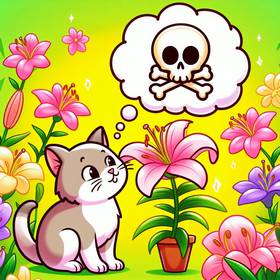Toxic Components in Lilies
Lilies can be beautiful additions to a garden or home, but they pose a significant risk to cats. The primary toxic component in lilies is found in the pollen, petals, and leaves. This toxic substance can cause severe kidney damage in cats, leading to symptoms like vomiting, lethargy, and decreased appetite. Even a small amount of lily ingestion can have serious consequences for a cat's health. It's crucial for cat owners to be aware of these toxic components and take preventive measures, such as keeping lilies out of reach and opting for cat-friendly plants instead.
Symptoms of Lily Poisoning in Cats
Symptoms of lily poisoning in cats can vary depending on the severity of the ingestion and the type of lily involved. Common signs include vomiting, drooling, loss of appetite, and lethargy. In more serious cases, cats may experience seizures, difficulty breathing, or even kidney failure. It's crucial to seek immediate veterinary attention if you suspect your cat has ingested any part of a lily plant.
Early detection and treatment can greatly improve the chances of a positive outcome. Your veterinarian may perform tests to assess kidney function and may administer supportive care such as intravenous fluids or medications to manage symptoms. Remember, prevention is key – keep lilies and other potentially toxic plants out of reach of your curious feline companion to ensure their safety and well-being.
Early detection and treatment can greatly improve the chances of a positive outcome. Your veterinarian may perform tests to assess kidney function and may administer supportive care such as intravenous fluids or medications to manage symptoms. Remember, prevention is key – keep lilies and other potentially toxic plants out of reach of your curious feline companion to ensure their safety and well-being.
Immediate Steps if Your Cat Ingests Lilies
If your cat ingests lilies, it's crucial to act swiftly. First, remove any remaining plant material from their mouth and paws to prevent further ingestion. Then, contact your veterinarian immediately for guidance. Be prepared to provide information such as the type of lily, the amount ingested, and your cat's current symptoms. Do not attempt home remedies without professional advice, as some can worsen the situation. Your vet may recommend inducing vomiting or administering activated charcoal to help absorb toxins. Time is of the essence in these situations, so don't delay seeking professional assistance for your cat's well-being.
Cat-Friendly Alternatives to Lilies
If you're looking for cat-friendly alternatives to lilies, there are plenty of safe options to brighten up your home without putting your feline friend at risk. Consider plants like spider plants, Boston ferns, or orchids, which are non-toxic to cats and add a touch of greenery to your space.
Another option is to opt for artificial flowers or dried arrangements, providing a similar aesthetic without the potential dangers. Additionally, you can create a cat-friendly garden with catnip, wheatgrass, or cat-safe herbs like parsley or mint, giving your cat a safe and enjoyable outdoor experience.
By choosing these alternatives, you can ensure a beautiful environment for yourself while keeping your cat healthy and happy.
Another option is to opt for artificial flowers or dried arrangements, providing a similar aesthetic without the potential dangers. Additionally, you can create a cat-friendly garden with catnip, wheatgrass, or cat-safe herbs like parsley or mint, giving your cat a safe and enjoyable outdoor experience.
By choosing these alternatives, you can ensure a beautiful environment for yourself while keeping your cat healthy and happy.
Tips for Creating a Safe Environment for Your Cat
Creating a safe and comfortable environment for your cat is essential for their well-being. Here are some tips to help you achieve that:
1. Provide Resources: Cats need their own space and resources. Make sure your cat has:
- A cozy bed or blanket where they can retreat and feel safe.
- Scratching posts or pads to satisfy their natural scratching behavior.
- Cat trees, perches, and shelves for climbing and exploring.
- Separate food and water dishes to avoid resource-sharing stress.
- A litter tray that is clean and easily accessible.
2. Quiet Zones: Cats appreciate quiet areas where they can nap undisturbed. Create cozy corners or secluded spots where your cat can relax without disruptions.
3. Balcony Safety: If you have a balcony, ensure it's cat-proofed. Use mesh or netting to prevent falls, and provide a comfortable spot for your cat to enjoy the outdoors safely.
4. Toxic Plants: Be cautious with indoor plants. Some plants, like tulips and roses, can be toxic to cats. Keep them out of reach or opt for cat-safe alternatives.
Remember, understanding your cat's needs and providing a stress-free environment will contribute to their happiness and overall health.
1. Provide Resources: Cats need their own space and resources. Make sure your cat has:
- A cozy bed or blanket where they can retreat and feel safe.
- Scratching posts or pads to satisfy their natural scratching behavior.
- Cat trees, perches, and shelves for climbing and exploring.
- Separate food and water dishes to avoid resource-sharing stress.
- A litter tray that is clean and easily accessible.
2. Quiet Zones: Cats appreciate quiet areas where they can nap undisturbed. Create cozy corners or secluded spots where your cat can relax without disruptions.
3. Balcony Safety: If you have a balcony, ensure it's cat-proofed. Use mesh or netting to prevent falls, and provide a comfortable spot for your cat to enjoy the outdoors safely.
4. Toxic Plants: Be cautious with indoor plants. Some plants, like tulips and roses, can be toxic to cats. Keep them out of reach or opt for cat-safe alternatives.
Remember, understanding your cat's needs and providing a stress-free environment will contribute to their happiness and overall health.



